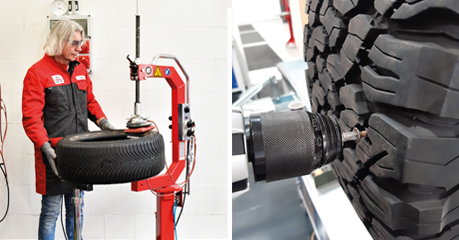Newsroom
Expert interview: Methods, limits and technical requirements for professional tire repair

Poing near Munich, January 25th, 2023. Despite the belief of many consumers, defective tires do not have to be replaced immediately. In most cases, they can be repaired professionally and remain in safe use for a long time. This helps to protect the environment and the car owner's wallet. Ludwig Ketzer has been working at tire repair specialist REMA TIP TOP for almost 40 years to ensure that tires are used for as long as possible in order to avoid waste, CO2 emissions and raw material consumption. In part two of our interview series, he explains common methods and limits of tire repair and what workshops need to offer for professional tire repair.
Saving raw materials and CO2 emissions as well as cost benefits clearly make the case for repairing car tires. Are there
Not really, almost any tire damage can be repaired on passenger cars, provided the tire still has sufficient tread depth and the damage is identified as repairable in the REMA TIP TOP damage tables. Exceptions to this are flat rolling damages, which cannot be repaired even with the most modern repair systems. Typical injuries, however, can usually be repaired quickly and reliably. These include damage to the sidewall, which is repaired with hot vulcanization. Puncture wounds in the tread can be repaired very easily with combi-systems, e.g. the TÜV-certified MINICOMBI from REMA TIP TOP, for extensions of 3-6 mm. For larger injuries up to 10 mm, hot vulcanization is used.
What needs to be considered when repairing passenger car tires? Which repair methods are used and what are the differences between them?
The repair must permanently seal an injury and completely restore the strength of the bond. The standard method is hot vulcanization, where the damage is filled with a special repair rubber and the carcass is strengthened with an appropriate repair patch. This procedure requires special equipment and takes longer than cold repair - about 50 minutes plus cooling, installation is possible immediately after cooling. In cold repair, a combi-system consisting of a plate and shaft is used, which has a bonding layer; the plate and shaft are already vulcanized, i.e. elastic. A vulcanizing solution accelerates or activates the bonding layer at room temperature. This allows the tire to be remounted very quickly and used immediately.
What do workshops require to perform professional tire repairs?
The legal basis for the repair of tubeless tires in Germany is specified in the "Guideline for the Repair of Pneumatic Tires," which is an extension of paragraph 36 of the German Road Traffic Licensing Regulations (StVZO). It regulates both the assessment of tire damage and the repair and restoration of tire damage. A professional workshop must be able to assess the tire and check whether it is worthy of repair and repairable. If this is the case, the tire may be repaired. Education and training play an important role in tire repair. That's why we educate businesses in the use of different repair systems for motorcycle, passenger car, truck, farm tractor and EM tires at the REMA TIP TOP Academy in Poing near Munich.
In general, specialized tire professionals should carefully follow the instructions of tire manufacturers and trade associations, especially the German Association of Tire Dealers and Vulcanizers (BRV), as well as the recommendations of the manufacturers of repair systems and materials.
What workshop equipment is needed to repair tires professionally?
This essentially depends on the tire types and the repair method. Workshops need significantly less space for repairing passenger car tires than for truck or heavy-duty vehicle tires. At its simplest, a partitioned repair area with a bright and clean workstation for cold repairs and a store for repair materials and tires is sufficient. More space is usually required for hot vulcanization. In addition, a vulcanizing unit, an air connection and/or compressor and a storage area for repair materials, which must be cool, dark and dry for rubber. In any case, it pays to plan more space for tire repair rather than too little. REMA TIP TOP will gladly advise its customers on details in individual cases or in training courses for specialized workshops.
Thank you very much for the interesting interview Mr. Ketzer!
Ludwig Ketzer is Head of Global Product Management & Application AUT (Automotive) at REMA TIP TOP AG.

